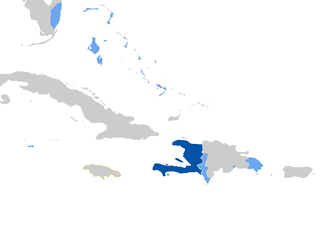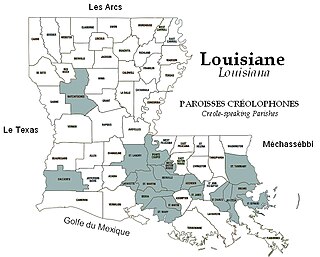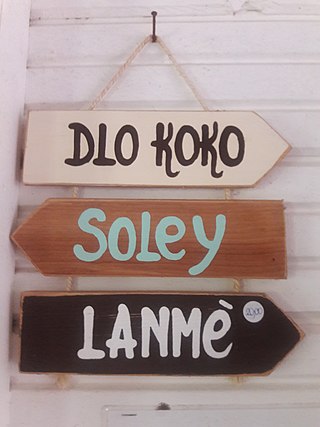
Haitian Creole, commonly referred to as simply Creole or Kreyòl natively, is a French-based creole language spoken by 10–12 million people worldwide, and is one of the two official languages of Haiti, where it is the native language of the vast majority of the population. Northern, Central, and Southern dialects are the three main dialects of Haitian Creole. The Northern dialect is predominantly spoken in Cap-Haïtien, Central is spoken in Port-au-Prince, and Southern in the Cayes area.

Seychellois Creole, also known as kreol, is the French-based creole language spoken by the Seychelles Creole people of the Seychelles. It shares national language status with English and French.

Louisiana Creole is a French-based creole language spoken by fewer than 10,000 people, mostly in the state of Louisiana. Also known as Kouri-Vini, it is spoken today by people who may racially identify as white, black, mixed, and Native American, as well as Cajun and Creole. It should not be confused with its sister language, Louisiana French, a dialect of the French language. Many Louisiana Creoles do not speak the Louisiana Creole language and may instead use French or English as their everyday languages.

Antillean Creole is a French-based creole that is primarily spoken in the Antilles. Its grammar and vocabulary include elements of French, Carib, English, and African languages.

Jamaican Patois is an English-based creole language with West African, Taíno, Irish, Spanish, Hindi, Portuguese, Chinese, and German influences, spoken primarily in Jamaica and among the Jamaican diaspora. Words or slang from Jamaican Patois can be heard in other Caribbean countries, the United Kingdom and Toronto, Canada. The majority of non-English words in Patois derive from the West African Akan language. It is spoken by the majority of Jamaicans as a native language.
Kassav' is a French Caribbean band formed in Guadeloupe in 1979. The core members of the band are Jacob Desvarieux, Jocelyne Béroard, Jean-Philippe Marthély, Patrick Saint-Éloi, Jean-Claude Naimro, Claude Vamur, and Georges Décimus. Kassav' have issued over 20 albums, with a further 12 solo albums by band members.
Big Drum is a genre, a musical instrument, and traditional African religion from the Windward Islands. It is a kind of Caribbean music, associated mostly closely with the music of Saint Vincent and the Grenadines, Music of Guadeloupe, Carriacou in Grenada and in the music of Saint Kitts and Nevis.
Limonese Creole is a dialect of Jamaican Patois, an English-based creole language, spoken in Limón Province on the Caribbean Sea coast of Costa Rica. The number of native speakers is unknown, but 1986 estimates suggests that there are fewer than 60,000 native and second language speakers combined.
The Afaka script is a syllabary of 56 letters devised in 1910 for the Ndyuka language, an English-based creole of Suriname. The script is named after its inventor, Afáka Atumisi. It continues to be used to write Ndyuka in the 21st century, but the literacy rate in the language for all scripts is under 10%.
"Fèy" is a traditional Vodou folk song in Haiti. In Haitian Creole, "fèy" means "leaf", and the lyrics of the song describe a leaf falling from a tree. Like many traditional songs in Vodou folklore, the lyrics of "Fèy" can hold many meanings, both religious and political. At least two mizik rasin bands in the 1990s sang adaptations of the traditional song. A version first performed by RAM in 1992 was banned throughout Haiti during the remaining years of the Raoul Cédras military junta.
"Haïti Chérie" is a traditional patriotic song of Haiti of a poem written by Othello Bayard that was initially called it Souvenir d'Haïti and composed to music in 1925. It is widely considered as a second national anthem, and one of Haiti's most famous méringues.
Misty Jean is a former Miss West Indies and singer. She sings in her native Haitian Creole / French language and also in English.
The term equative is used in linguistics to refer to constructions where two entities are equated with each other. For example, the sentence Susan is our president, equates two entities "Susan" and "our president". In English, equatives are typically expressed using a copular verb such as "be", although this is not the only use of this verb. Equatives can be contrasted with predicative constructions where one entity is identified as a member of a set, such as Susan is a president. This view has been contrasted by Otto Jespersen in the first part of the XX century and by Giuseppe Longobardi and Andrea Moro in the second. In particular, Andrea Moro in 1988 proved that either demonstrative phrases (DP) must be non referential in the sense of Geach (1962) by exploiting arguments based on binding theory. The idea is that when a DP plays the role of predicate it enlarges its binding domain: for example, in John met his cook the pronoun can refer to the subject John but in John is his cook it cannot. The key-step was to admit that the DP following the copula can be referential whereas the one preceding must not, in other words the key-step was to admit that there can be inverse copular sentences, namely those where the subject, which is referential, follows the predicate. For a discussion starting from Moro's data see Heycock (2012). For a historical view of the development of the analysis of the copula see Moro
Saint Lucian Creole is a French-based creole language that is widely spoken in Saint Lucia. It is the vernacular language of the country and is spoken alongside the official language of English. It is important that Kwéyòl is recognised as a language on its own merits as it possesses a clear grammatical structure, syntax, vocabulary and punctuation.
Marlène Rigaud Apollon is a Haitian educator and writer who has been living in the United States since 1964.
D. Daly is a French singer-songwriter, composer, actor and music producer.
Karipúna French Creole, also known as Amapá French Creole and Lanc-Patuá, is a French-based creole language spoken by the Karipúna community, which lives in the Uaçá Indian Reservation in the Brazilian state of Amapá, on the Curipi and Oyapock rivers. It is mostly French-lexified except for flora and fauna terms, with a complex mix of substratum languages—most notably the Arawakan Karipúna language.

Vive la Canadienne was the anthem of French Canadians in Quebec before it was replaced by O Canada. According to Ernest Gagnon, it was based on an old French tune, Par derrièr' chez mon père.
Glaubst du an die Unsterblichkeit der Seele? is an unfinished 1983 chamber piece by Canadian composer Claude Vivier. It is one of his most famous compositions, as the libretto is claimed by some to have predicted the composer's own murder in March of the same year. The piece was left incomplete and unrevised with just three short movements, a typical performance lasting around eight minutes.





